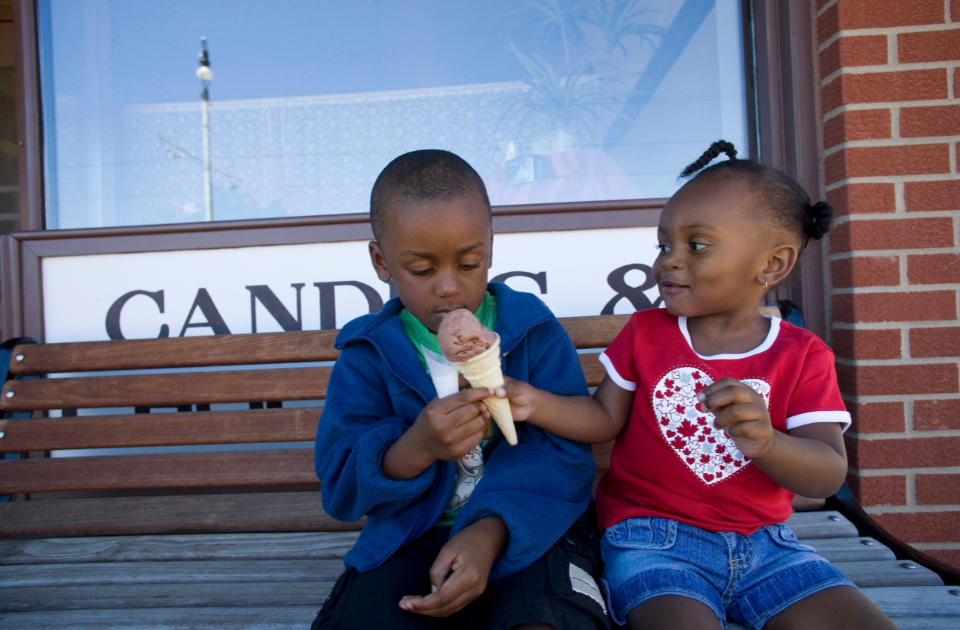Very few people enjoy being poked with needles, and a good percentage of the adult population is actively afraid of it. So it's no surprise when young kids cry when it's time for a shot or when they have to get their blood taken. Who can blame them? It sucks.
For Morgan Handley's son, Reece, that discomfort is not just a once-a-year ordeal, but a biweekly one. The five-year-old was diagnosed with leukemia three years ago and has to get his blood drawn regularly. The way he psyches himself up for it—despite clearly being upset by it—has people cheering him on and inspired to take the same approach to hard things they don't want to do.
Watch:
@morganprainsJust my 5 year olds version of a pep talk for his lab draw this week…. He’s had his labs done at least bi weekly for almost 3 years 🥹🤣 #fyp #childhoodcancerawareness #roarlikeReece #fcancer
His "Heck yeah! Do it. Just do it." would be enough on its own, but the enthusiastic "Yeah, boy! That's what I'm talkin' about!" is such a flex. The little warrior clearly knows what works for him, and his courage through his tears is exactly what we all wish we could muster when we're going through something hard.
Handley tells Upworthy that it's something he's internalized from the family. "We pep him up, always, but it’s carried over over the years," she says. "And now he just naturally does it, even to us when we have things that have to get done!"
People loved how he handled it:
"Him crying while cheering himself on broke my heart and made me laugh at the same time."
"He figured out it's mind over matter!"
"He handled that better than some grown men I know! Hahah"
 Many grown men don't handle getting their blood taken very well.Photo credit: Canva
Many grown men don't handle getting their blood taken very well.Photo credit: Canva
"I don't even have kids and I want to get him whatever toys he wants after this."
"Look at that brave little guy! He pep talked himself through the anxiety and pain!!"
Handley shared that Reece is set to ring the bell—declaring that he's cancer-free—in July of 2025. It's been a long road to get there. He was diagnosed with leukemia in September of 2022 after going to the ER for fever blisters that had turned into a rash around his mouth and what seemed like an allergic reaction. Noticing Reece looked pale, the ER doctor took his blood and found a white cell count of 80,000, which was an indication of leukemia. After being transferred to the children's hospital, doctors rechecked his blood cell count and confirmed it.
That's where the family's cancer journey began, meeting with doctors, coming up with a plan, and starting treatment. Thankfully, he was able to start immunotherapy treatment as part of a St. Jude's trial, which has been shown to reduce relapse rates. Immunotherapy treatment is now part of standard protocol, says Handley.
"Treatment has been decently smooth," she tells Upworthy. "He has sensitive skin so lots of rashes to every medicine ever. Steroids do a number on kids. In the beginning he stopped walking, but he overall hasn’t had terrible reactions. Immunotherapy was a smooth part of treatment."
@morganprainsReplying to @Hannah Fountain sorry it’s so long 😆 #fcancer #childhoodcancerawareness #diagnosis
Reece's specific form of leukemia is acute lymphocytic (or lymphoblastic) leukemia (ALL), a cancer of the bone marrow and blood that progresses rapidly and creates immature blood cells rather than mature ones. It's the most common form of childhood cancer, according to the Mayo Clinic. Thankfully, it's now more treatable than many other forms of cancer, with a high survival rate, especially for those diagnosed as young children.
Handley shared another video that illustrates how much of a day-by-day process it is go to through cancer treatment as a child. She said how Reece deals with blood draws "depends on the day."
@morganprainsReplying to @Morgan Handley truly an inspiration. I’m so proud of this kid. He is a literal hero. The unfortunate reality is needle pokes are a frequent occurrence in cancer treatment. Most days he just makes the best of it 🥹🤪❤️🩹 #childhoodcancerawareness #roarlikeReece
People in the comments have been encouraging and some have even shared their own stories with childhood leukemia, offering hope to Handley and her family.
"My brother was also diagnosed with leukemia at 2 - remission at 5. I was born right after he was diagnosed. So much similarity. He’s been cancer free for 35 years…praying for y’all!"
"My sister was diagnosed with acute lymphoblastic leukemia at age 2 as well and beat it by the age of 6. It stunted her growth significantly but other than that she’s 25 and thriving!!"
"I had a hemoglobin of 4 the day I was diagnosed with ALL at 6 years old. Very pale, very weak. Biggest clue was I couldn’t keep up in PE & my mom had a gut feeling. I’ve been cancer free for almost 28 years now. I also became a nurse because of this experience. Much love to you all."
"My oldest boy was 3 when he was diagnosed with stage 3 Clear Cell Sarcoma. He is now cancer free and 8 years old. We had another boy and expecting our little girl in October. I pray your little boy a long healthy life he deserves."
However, an increase in positive outcomes doesn't make treatment any more enjoyable or the process any easier for a parent.
"I want people to know how hard it is to watch you kid lose himself and struggle with simple kid things because you’re trying to save his life," says Handley. "I want people to know that the reality is living in fear of death for your child. Everyday. Relapse, everyday. But celebrating every single good thing that comes."
@morganprainsReplying to @Belinda_H12 thank you for this 🧡 #childhoodcancerawareness
She calls Reece "a literal superhero," and people agree. Seeing how this kiddo had learned to take on his challenges with gusto-filled resilience and enthusiasm is something we can all learn from.
You can follow Morgan Handley for more updates on TikTok.





 An intelligent man's thought process.
An intelligent man's thought process. Kids showing kindness through sharing.
Kids showing kindness through sharing.  Many grown men don't handle getting their blood taken very well.
Many grown men don't handle getting their blood taken very well. A "girl gang" in 1976. via
A "girl gang" in 1976. via  GIrls in class in the 1960s.via
GIrls in class in the 1960s.via  A woman is upset looking at her smartphone.via
A woman is upset looking at her smartphone.via  A group of people protesting in the street.via
A group of people protesting in the street.via  Trump supporters at a rally.via
Trump supporters at a rally.via